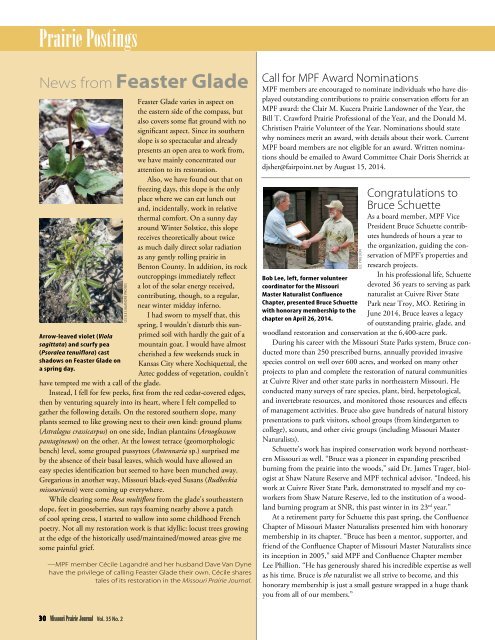yBg7W
yBg7W
yBg7W
Create successful ePaper yourself
Turn your PDF publications into a flip-book with our unique Google optimized e-Paper software.
Prairie PostingsNews from Feaster GladeArrow-leaved violet (Violasagittata) and scurfy pea(Psoralea tenuiflora) castshadows on Feaster Glade ona spring day.Cécile Lagandré photosFeaster Glade varies in aspect onthe eastern side of the compass, butalso covers some flat ground with nosignificant aspect. Since its southernslope is so spectacular and alreadypresents an open area to work from,we have mainly concentrated ourattention to its restoration.Also, we have found out that onfreezing days, this slope is the onlyplace where we can eat lunch outand, incidentally, work in relativethermal comfort. On a sunny dayaround Winter Solstice, this slopereceives theoretically about twiceas much daily direct solar radiationas any gently rolling prairie inBenton County. In addition, its rockoutcroppings immediately reflecta lot of the solar energy received,contributing, though, to a regular,near winter midday inferno.I had sworn to myself that, thisspring, I wouldn’t disturb this sunprimedsoil with hardly the gait of amountain goat. I would have almostcherished a few weekends stuck inKansas City where Xochiquetzal, theAztec goddess of vegetation, couldn’thave tempted me with a call of the glade.Instead, I fell for few peeks, first from the red cedar-covered edges,then by venturing squarely into its heart, where I felt compelled togather the following details. On the restored southern slope, manyplants seemed to like growing next to their own kind: ground plums(Astralagus crassicarpus) on one side, Indian plantains (Arnoglossumpantagineum) on the other. At the lowest terrace (geomorphologicbench) level, some grouped pussytoes (Antennaria sp.) surprised meby the absence of their basal leaves, which would have allowed aneasy species identification but seemed to have been munched away.Gregarious in another way, Missouri black-eyed Susans (Rudbeckiamissouriensis) were coming up everywhere.While clearing some Rosa multiflora from the glade’s southeasternslope, feet in gooseberries, sun rays foaming nearby above a patchof cool spring cress, I started to wallow into some childhood Frenchpoetry. Not all my restoration work is that idyllic: locust trees growingat the edge of the historically used/maintained/mowed areas give mesome painful grief.—MPF member Cécile Lagandré and her husband Dave Van Dynehave the privilege of calling Feaster Glade their own. Cécile sharestales of its restoration in the Missouri Prairie Journal.Call for MPF Award NominationsMPF members are encouraged to nominate individuals who have displayedoutstanding contributions to prairie conservation efforts for anMPF award: the Clair M. Kucera Prairie Landowner of the Year, theBill T. Crawford Prairie Professional of the Year, and the Donald M.Christisen Prairie Volunteer of the Year. Nominations should statewhy nominees merit an award, with details about their work. CurrentMPF board members are not eligible for an award. Written nominationsshould be emailed to Award Committee Chair Doris Sherrick atdjsher@fairpoint.net by August 15, 2014.Bob Lee, left, former volunteercoordinator for the MissouriMaster Naturalist ConfluenceChapter, presented Bruce Schuettewith honorary membership to thechapter on April 26, 2014.Lee PhillionCongratulations toBruce SchuetteAs a board member, MPF VicePresident Bruce Schuette contributeshundreds of hours a year tothe organization, guiding the conservationof MPF’s properties andresearch projects.In his professional life, Schuettedevoted 36 years to serving as parknaturalist at Cuivre River StatePark near Troy, MO. Retiring inJune 2014, Bruce leaves a legacyof outstanding prairie, glade, andwoodland restoration and conservation at the 6,400-acre park.During his career with the Missouri State Parks system, Bruce conductedmore than 250 prescribed burns, annually provided invasivespecies control on well over 600 acres, and worked on many otherprojects to plan and complete the restoration of natural communitiesat Cuivre River and other state parks in northeastern Missouri. Heconducted many surveys of rare species, plant, bird, herpetological,and invertebrate resources, and monitored those resources and effectsof management activities. Bruce also gave hundreds of natural historypresentations to park visitors, school groups (from kindergarten tocollege), scouts, and other civic groups (including Missouri MasterNaturalists).Schuette’s work has inspired conservation work beyond northeasternMissouri as well. “Bruce was a pioneer in expanding prescribedburning from the prairie into the woods,” said Dr. James Trager, biologistat Shaw Nature Reserve and MPF technical advisor. “Indeed, hiswork at Cuivre River State Park, demonstrated to myself and my coworkersfrom Shaw Nature Reserve, led to the institution of a woodlandburning program at SNR, this past winter in its 23 rd year.”At a retirement party for Schuette this past spring, the ConfluenceChapter of Missouri Master Naturalists presented him with honorarymembership in its chapter. “Bruce has been a mentor, supporter, andfriend of the Confluence Chapter of Missouri Master Naturalists sinceits inception in 2005,” said MPF and Confluence Chapter memberLee Phillion. “He has generously shared his incredible expertise as wellas his time. Bruce is the naturalist we all strive to become, and thishonorary membership is just a small gesture wrapped in a huge thankyou from all of our members.”30 Missouri Prairie Journal Vol. 35 No. 2


